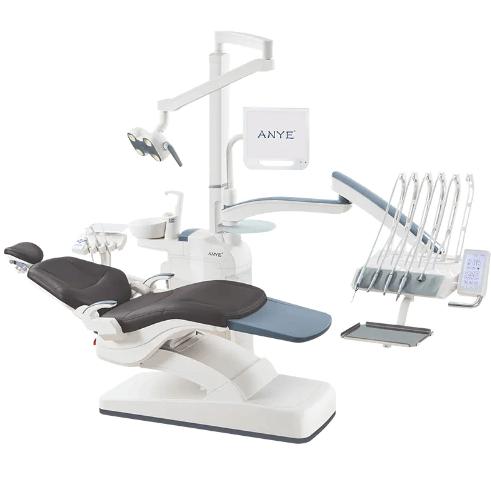How to Choose the Right Dental Unit Tray
The dental unit tray is an essential component of a dental chair setup. It serves as a platform for holding various dental tools, equipment, and materials required during dental procedures.
Choosing the right dental unit tray is crucial for ensuring optimal clinical outcomes, patient comfort, and safety. In this guide, we will explore the key considerations when selecting a dental unit tray.
Choosing the right dental unit tray is crucial for ensuring optimal clinical outcomes, patient comfort, and safety. In this guide, we will explore the key considerations when selecting a dental unit tray.
Importance of Choosing the Right Dental Unit Tray
Before guide you how to choose the right dental unit unit, the author would illustrate why it is important to choose the right dental unit tray.
●Enhancing clinical performance and efficiency
Choosing the right dental unit tray can significantly impact clinical performance and efficiency. The tray's layout, size, and material can affect the ease of accessing and organizing dental instruments, leading to increased productivity and accuracy during procedures.
●Improving patient experience and comfort
A well-designed dental unit tray can also improve patient experience and comfort. An ergonomic tray that accommodates a patient's positioning can reduce strain and discomfort during the procedure, resulting in a positive patient experience.
●Reducing the risk of cross-contamination
The risk of cross-contamination is a significant concern in the dental industry. A dental unit tray made of high-quality, non-porous material that is easy to disinfect can reduce the risk of contamination, ensuring patient and clinician safety.
●Ensuring durability and longevity
A durable dental unit tray made of high-quality materials can withstand frequent use, reducing the need for replacement and saving costs in the long run.
●Saving time and cost in the long run
Investing in the right dental unit tray can save time and costs in the long run. A well-designed tray that is easy to clean and organize can reduce procedure time and increase productivity, ultimately leading to cost savings.
Considerations When Choosing a Dental Unit Tray
In this section, the author would list some majors considerations when you are choosing a dental unit tray.
●Purpose of the Tray
The purpose of the dental unit tray determines the required size, layout, and material. A tray used for restorative procedures will have different requirements than a tray used for surgical procedures. It is important to consider the specific needs of the procedure and select a tray that is designed for that purpose.
●Size and Dimensions
The size and dimensions of the tray should match the specific needs of the dental procedure and accommodate the patient's positioning comfortably. A tray that is too small or too large can impact the ease of accessing and organizing instruments, leading to reduced productivity and accuracy.
●Material of the Tray
The material of the tray impacts its durability, disinfection properties, and weight. Stainless steel and plastic are popular materials for dental unit trays. Stainless steel trays are durable, easy to clean, and long-lasting. Plastic trays are lightweight, easy to handle, and cost-effective.
●Weight and Portability
The weight and portability of the tray impact its ease of use and storage. A lightweight tray that is easy to move and store can increase efficiency. However, the tray should not be too lightweight that it becomes unstable or prone to tipping over.
●Number of Compartments
The number of compartments on the tray determines the organization of instruments and materials during the procedure. The tray should have sufficient compartments to accommodate the specific requirements of the procedure. A well-organized tray can increase efficiency, reduce procedure time, and improve clinical outcomes.
●Ergonomics and Comfort
An ergonomic tray that accommodates the patient's position and reduces strain on the clinician can improve patient comfort and clinician performance. The tray should be designed to allow easy access to instruments and materials, reducing the need for awkward positioning or stretching.
●Price and Budget
The price of the tray should align with its features and benefits. A balance between quality and cost should be considered. While a more expensive tray may have additional features, it may not necessarily be the best fit for the specific needs of the practice. It is important to consider the long-term costs and benefits when selecting a tray.
●Brand and Manufacturer
The brand and manufacturer's reputation for quality and customer service should be considered when selecting a dental unit tray. A reputable brand with a history of providing high-quality products and excellent customer service can provide peace of mind and support.
Conclusion
Choosing the right dental unit tray is crucial for ensuring optimal clinical outcomes, patient comfort, and safety. A well-designed tray can enhance clinical performance, reduce the risk of cross-contamination, and save time and costs in the long run.
Dental professionals should consider all relevant factors when selecting a dental unit tray, including purpose, size, material, weight, compartments, ergonomics, price, and brand. Each factor should be carefully evaluated to ensure the tray meets the specific needs of the practice.
Dental professionals should consider all relevant factors when selecting a dental unit tray, including purpose, size, material, weight, compartments, ergonomics, price, and brand. Each factor should be carefully evaluated to ensure the tray meets the specific needs of the practice.



Leave a comment